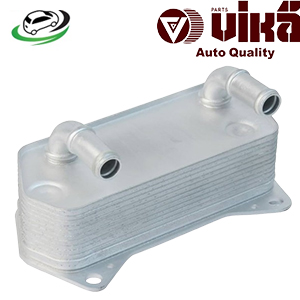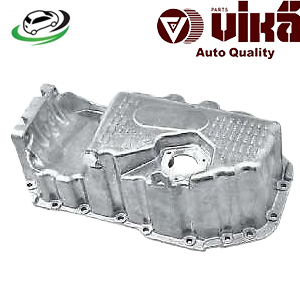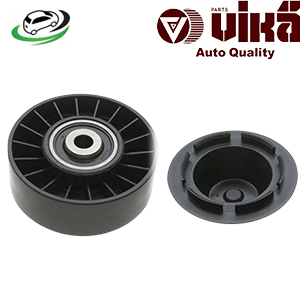-11%
Get AUDI A3 (8L1)/ A3 (8P1)/ A3 Sportback (8PA) / VW Bora I (1J2)/ Golf IV (1J1)/ Polo Variant (6V5) Drive Belt Idler Pulley 38145276
The drive belt idler pulley is a crucial component in the automotive engine system, playing a vital role in the operation of the engine’s accessory drive belt system. This component helps manage the tension and alignment of the drive belt, ensuring that all connected accessories operate efficiently. In this detailed explanation, we will explore the function, importance, types, symptoms of failure, maintenance practices, and overall benefits of the drive belt idler pulley in approximately 1000 words.
1. What is a Drive Belt Idler Pulley?
The drive belt idler pulley is a small, round wheel mounted on a bracket and designed to maintain tension in the drive belt system of an internal combustion engine. This pulley typically has a bearing inside that allows it to rotate smoothly. The idler pulley does not drive any accessories directly; rather, it guides the belt and maintains the necessary tension to ensure that the belt operates effectively.
The drive belt, also known as the serpentine belt, is responsible for powering various accessories, including the alternator, power steering pump, water pump, and air conditioning compressor. The idler pulley plays a crucial role in maintaining the proper routing and tension of this belt, ensuring optimal performance.
2. Function of the Drive Belt Idler Pulley
A. Tension Maintenance
One of the primary functions of the drive belt idler pulley is to maintain the correct tension in the drive belt. Proper tension is essential for efficient operation; too much tension can lead to premature wear of the belt and associated components, while too little tension can cause slippage, reducing the effectiveness of the accessories powered by the belt.
B. Belt Alignment
The idler pulley also helps in aligning the drive belt correctly. Proper alignment ensures that the belt runs smoothly over the pulleys and prevents unnecessary wear. Misalignment can lead to belt fraying, reduced efficiency, and potential damage to the engine components.
C. Noise Reduction
By guiding the drive belt and maintaining tension, the idler pulley helps reduce noise generated during operation. A well-functioning idler pulley allows for smooth belt operation, minimizing vibrations and noise that can occur when the belt slips or rubs against other components.
D. Supporting Accessory Drive Components
The idler pulley contributes to the overall functioning of the engine’s accessory drive system by ensuring that the belt delivers power to all connected components efficiently. This is crucial for the operation of essential accessories like the alternator and water pump.
3. Importance of the Drive Belt Idler Pulley
A. Preventing Belt Failure
A properly functioning drive belt idler pulley is essential for preventing belt failure. A worn or malfunctioning idler pulley can cause the belt to become loose or misaligned, leading to increased wear and potential failure. Regular maintenance of the idler pulley helps extend the life of the drive belt.
B. Enhancing Engine Efficiency
The efficiency of the engine’s accessory drive system directly affects overall engine performance. A properly tensioned and aligned drive belt ensures that accessories operate efficiently, contributing to better fuel economy and smoother engine performance.
C. Protecting Other Components
The idler pulley plays a protective role in the engine system. By maintaining proper tension and alignment of the drive belt, it prevents damage to other components, such as the alternator, power steering pump, and water pump, which could be costly to repair or replace.
D. Supporting Engine Longevity
Regular maintenance of the idler pulley and the drive belt system contributes to the longevity of the engine. By preventing unnecessary wear and tear on the drive belt and associated components, the idler pulley helps ensure that the engine operates smoothly for a more extended period.
4. Types of Drive Belt Idler Pulleys
A. Standard Idler Pulleys
Standard idler pulleys are typically made from durable materials such as plastic or metal. They feature a simple design, including a smooth surface for the drive belt to run against. These pulleys are commonly found in most vehicles and are suitable for standard applications.
B. Adjustable Idler Pulleys
Adjustable idler pulleys allow for tension adjustment in the drive belt system. These pulleys feature a mechanism that enables users to modify the pulley position, helping maintain the correct tension as the drive belt wears over time. Adjustable pulleys are often used in high-performance or modified vehicles.
C. Tensioner Pulleys
Some drive belt systems incorporate tensioner pulleys, which combine the functions of an idler pulley and a tensioning mechanism. These pulleys automatically adjust the tension of the drive belt as it wears, ensuring optimal performance without manual adjustments.
D. Heavy-Duty Idler Pulleys
Heavy-duty idler pulleys are designed for use in commercial or high-performance applications. These pulleys are built with more robust materials and can withstand higher loads and stress. Heavy-duty pulleys are commonly found in trucks, SUVs, and performance vehicles.
5. Symptoms of a Failing Drive Belt Idler Pulley
Recognizing the symptoms of a failing drive belt idler pulley is crucial for maintaining the health of your vehicle’s engine. Here are some common signs to watch for:
A. Unusual Noises
A failing idler pulley may produce squeaking, squealing, or grinding noises. These sounds often indicate that the pulley bearings are worn or that the drive belt is slipping or misaligned.
B. Belt Slippage
If you notice that the drive belt is slipping off the pulleys or has become loose, it could indicate a problem with the idler pulley. A worn or damaged pulley may not maintain the necessary tension, leading to slippage and reduced accessory performance.
C. Visible Wear or Damage
Inspect the idler pulley for visible signs of wear, such as cracks, fraying, or deterioration of the pulley surface. A damaged pulley can lead to further issues in the drive belt system.
D. Engine Performance Issues
If you experience a decrease in engine performance, such as difficulty starting or reduced power, it may be due to a failing idler pulley affecting the operation of the alternator or other accessories.
E. Warning Lights
In some vehicles, a failing idler pulley may trigger warning lights on the dashboard, indicating a problem with the engine or accessory drive system. Pay attention to any warning lights that appear, as they may require immediate attention.
6. Maintenance of the Drive Belt Idler Pulley
Proper maintenance of the drive belt idler pulley is essential for ensuring the longevity of your vehicle’s engine. Here are some best practices:
A. Regular Inspections
Regularly inspect the drive belt and idler pulley for signs of wear or damage. Look for fraying or cracking in the belt and any visible wear on the pulley surface. Early detection of problems can prevent further issues down the road.
B. Belt Replacement
The drive belt should be replaced according to the manufacturer’s recommended schedule, typically every 60,000 to 100,000 miles, depending on the vehicle and driving conditions. A worn belt can put additional stress on the idler pulley, leading to premature failure.
C. Cleaning the Pulley
Keep the idler pulley clean and free from debris. Dirt and grime can accumulate on the pulley and cause increased friction, leading to premature wear. A soft cloth or brush can be used to clean the pulley gently.
D. Check Tension
If your vehicle has an adjustable or tensioner idler pulley, regularly check the tension of the drive belt. Ensure that the belt maintains the correct tension, as improper tension can lead to excessive wear and performance issues.
E. Listen for Noises
Pay attention to any unusual noises when the engine is running. If you hear squeaking, squealing, or grinding sounds, it may be time to inspect the idler pulley and consider replacement if necessary.
F. Professional Maintenance
Consider having a professional mechanic inspect the drive belt and idler pulley during routine maintenance. A trained technician can identify potential issues and recommend necessary repairs or replacements.
7. Conclusion
The drive belt idler pulley is a vital component of the automotive engine system, playing a crucial role in maintaining the tension and alignment of the drive belt. Its function directly impacts the performance and longevity of various engine accessories, making it essential for overall engine efficiency.
Understanding the importance of the drive belt idler pulley, recognizing the signs of failure, and adhering to proper maintenance practices will help keep your vehicle running smoothly. Whether you are a daily commuter or a performance enthusiast, ensuring that your drive belt system operates effectively is key to enjoying reliable and efficient vehicle performance. Regular attention to the idler pulley can save you from costly repairs and extend the life of your engine and its accessories.
Follow us on Facebook for more parts.




Reviews
Clear filtersThere are no reviews yet.